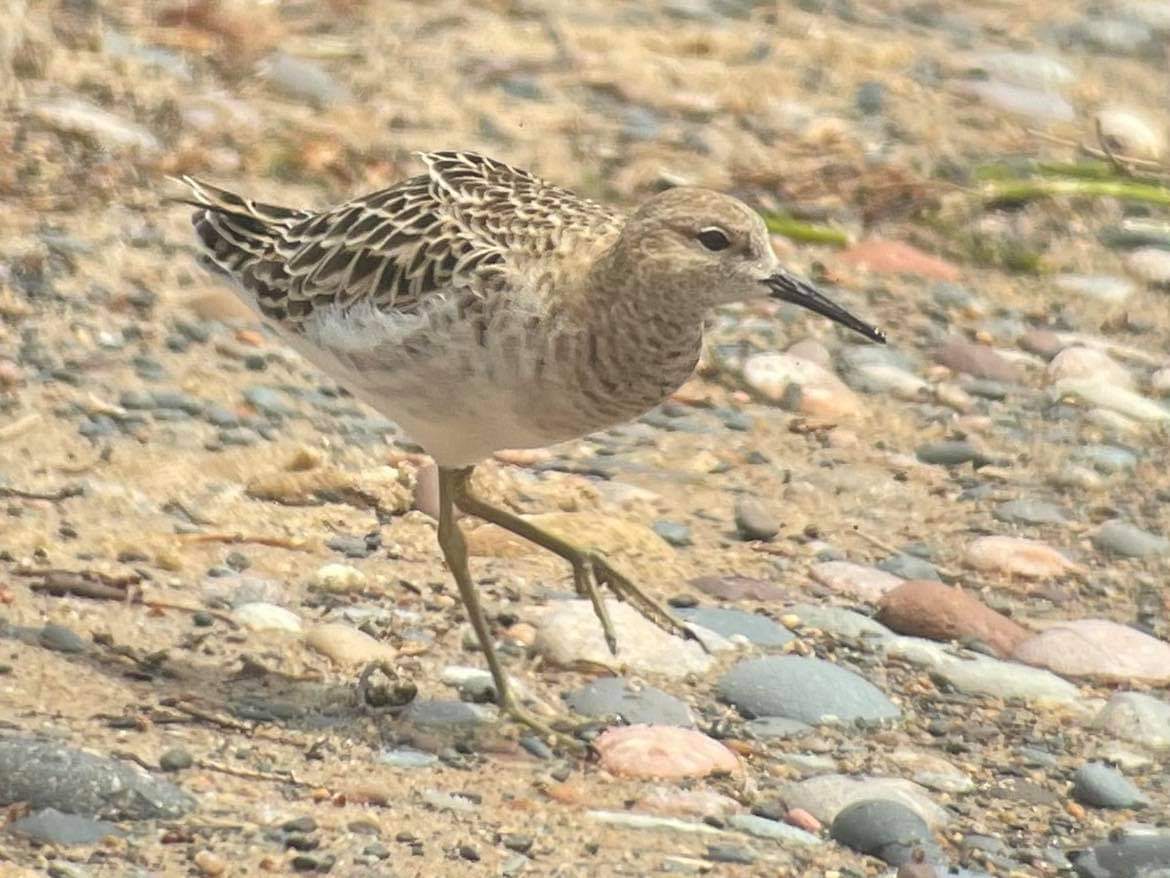Here at Whitefish Point Bird Observatory (WPBO), the spring waterbird count begins April 15 and goes for six weeks, ending May 31. During this time, I was tasked with counting all the waterbirds I could see that passed the Point on their way north for the summer breeding season. My inaugural season as the waterbird counter here at WPBO was a fun and interesting season. I enjoyed chatting with visitors about birds and migration, with many non-birders often asking what I was doing out there, standing on the beach. It provided an excellent opportunity to talk birds with them, opening their world just a little and enlightening them about these animals.
This season was an interesting one, seemingly defined by steady north or northwest winds for most of the count. Winds were typically in the 20- to 30-mph range (or so), with a “calm” day being 15 mph or less. This combination of strong, sustained winds undoubtedly had its effects on the count. Birds of any sort much prefer to migrate with a tailwind rather than a headwind; tailwinds save the bird energy and make the migration journey much easier. Day after day, I watched and waited, hoping the wind would die down or change direction to south or southeast. This season I never detected any real big push of waterbirds migrating at any given time. It was mostly a smattering of waterbirds here and there. I found this odd as I usually associate a big push of waterbirds with spring migration, at least at some point.
Early in the season is usually when most of the dabblers move through — Mallard, American Wigeon, Northern Shoveler, Black Duck, Northern Pintail, and teal. While we were treated to all these ducks (and we saw a couple of nice mixed-species groups fly by), these were very brief encounters, being more of an exception and not the rule this season.
The loons dictated mid-season. Here at WPBO, it’s the Common Loon migration that’s most impressive. We also see Red-throated Loons migrate by, but the Common Loon flight is really the frosting on the cake. It is always remarkable and something of a treat to watch Common Loons buzz right over the waterbird shack. These are special moments too. Most often, though, the loons choose very distant flight lines, either way out over Lake Superior toward Canada or way to the south of Whitefish Bay, when they decide to cut overland across the point. This requires your head to be on a swivel, constantly scanning the sky, and it paid off with around 3,500 Common Loons being counted this season.
With bulk loon migration fading into the rearview mirror, it was time to welcome the scoters and Long-tailed Ducks. Here at WPBO, the White-winged Scoter is the show’s main act, although we do get a fair showing of Surf Scoters and a sprinkling of Black Scoters. On a good scoter or Long-tailed Duck day, it’s quite possible to count hundreds or even thousands of birds migrating by. Unfortunately, a good scoter or Long-tailed Duck day never materialized, which left me somewhat miffed. Where did they all go? Was it the poor wind conditions that ruled most of the season? Did the bulk of migration happen at night? We do know ducks prefer to migrate nocturnally. It left me feeling that it would be tough to overcount scoters or Long-tailed Ducks when conducting a diurnal count here at WPBO.
Late season, things slowed way down; many an hour went by with not a single waterbird sighting to report. To spice it up, though, we did enjoy an excellent movement of shorebirds — nothing in the way of huge numbers that would blow you out of the water, but a nice variety. These included Dunlin, Ruddy Turnstone, Sanderling, Pectoral Sandpiper, Red Knot, Black-bellied Plover, American Golden-Plover, White-rumped Sandpiper, yellowlegs, Stilt Sandpiper, and Short-billed Dowitcher. The season also welcomed a rarity and first record at the Point of a Ruff, found by Alec Olivier. Congratulations to Alec on this fantastic find! Whimbrel, which ordinarily makes a good showing here at WPBO, didn’t show up in the numbers we typically expect and only had a light scattered appearance. Later in May, we did have three adult Parasitic Jaegers fly by the Point; these are a very nice treat to see during the spring waterbird count. They are more typical during the fall count here at WPBO.
Daily High Counts and Season Totals for Highlighted Species
Sandhill Crane
DHC: 4,148 on April 18 | Season total: 6,402
Red-necked Grebe
DHC: 104 on May 2 | Season total: 566
Common Loon
DHC: 347 on May 7 | Season total: 3,486
White-winged Scoter
DHC: 606 on May 20 | Season total: 1,981
Long-tailed Duck
DHC: 857 on May 23 | Season total: 1,289
Red-breasted Merganser
163 on May 24 | Season total: 2,179
To pin the tail on a duck and summarize this season, it was an interesting one for sure. One day, there were birds; the next, there were none, seemingly with no rhyme or reason (though I think the weather patterns were a factor). I don’t know if this is something to be concerned about as a long-term trend, as a sign of bigger environmental issues, or just a blip on the seasonal radar screen. To be sure, I had a fun season here at WPBO counting birds, discussing them with visitors, bringing them to you through my blogs and social posts, and connecting you to the wonders of the natural world. It was my pleasure to share this season with all of you. I learned a lot in the six weeks I spent at WPBO.
A special thank you must go to volunteers Rhoda Johnson and Darrell Lawson, who took the time to come up to Whitefish Point and give me the occasional and much-needed day off. Thank you to both of you.
Lastly, I’d like to thank all of you for tuning into the season with me. Happy birding to you all!
~ by Matthew Winkler, WPBO spring waterbird counter
Featured photo: A first record Ruff at Whitefish Point Bird Observatory took place on May, 21, 2021. Photo by Alec Olivier

Matthew Winkler is a lifelong bird nerd. His first adventure to Whitefish Point was in 1995 at around age 7, and he’s been visiting the Point most years since. He strongly advocates for citizen science, good mentorship, and connecting more people to the world of birds.
This article appeared in the 2021 Summer Jack Pine Warbler.

